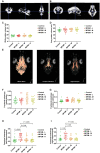Milk fat globule membrane promotes brain development in piglets by enhancing the connection of white matter fiber trace
- PMID: 38075212
- PMCID: PMC10701284
- DOI: 10.3389/fnut.2023.1248809
Milk fat globule membrane promotes brain development in piglets by enhancing the connection of white matter fiber trace
Abstract
Introduction: Brain development during infancy is crucial for later health and development. Although Milk Fat Globule Membrane (MFGM) has been demonstrated to enhance brain development, further investigation is needed to determine the optimal dose.
Methods: In this study, 80 piglets aged 2 days were randomly assigned to four groups: Control group, MFGM-L (1.74 g MFGM per 100 g diet), MFGM-M (4.64 g MFGM per 100 g diet), and MFGM-H (6.09 g MFGM per 100 g diet). Daily body weight and milk intake of the piglets were recorded until 31 days postnatal. Learning and memory abilities were evaluated using the spatial T-maze test on day 15. MRI analysis was conducted to assess functional and structural changes in brain tissues. Additionally, mRNA and protein expression of brain-derived neurotrophic factor (BDNF) and neurotrophin-3 (NTF-3) in the hippocampus and prefrontal cortex were evaluated.
Results: The results indicated that the MFGM supplemented diet significantly improved the accuracy of the piglets in the T-maze test, with the MFGM-L group exhibiting the best performance. MRI showed no volumetric differences in the gray and white matter between the groups. However, the fractional anisotropy in the left and right hippocampus of piglets in the MFGM-L group was significantly higher than in the other three groups. Furthermore, there was a strong correlation between the accuracy of the T-maze test and hippocampal fractional anisotropy.
Discussion: The MFGM supplemented diet also increased the expression of BDNF in the cerebral cortex. However, the changes in BDNF were not consistent with the results of the T-maze test. In conclusion, adding 1.74 g MFGM per 100 g diet can significantly improve neonatal piglets' learning and memory abilities, potentially by enhancing the connection of white matter fiber bundles in the brain.
Keywords: BDNF; MFGM; fractional anisotropy (FA); infant diet; memory-improvement.
Copyright © 2023 Zhang, Zhao, Man-Yau, Pan, Gao, Li, Tang, Wang, Tang, Zhao, Hao, Duan, Yan, Li and Zhong.
Conflict of interest statement
ZiZ, JH, SM-Y, YY, SD, and TL are affiliated with Inner Mongolia Yili Industrial Group Co., Ltd. and Inner Mongolia Dairy Technology Research Institute Co. Ltd. The remaining authors declare that the research was conducted in the absence of any commercial or financial relationships that could be construed as a potential conflict of interest.
Figures





Similar articles
-
Impacts of Formula Supplemented with Milk Fat Globule Membrane on the Neurolipidome of Brain Regions of Piglets.Metabolites. 2022 Jul 26;12(8):689. doi: 10.3390/metabo12080689. Metabolites. 2022. PMID: 35893256 Free PMC article.
-
Dietary Prebiotics, Milk Fat Globule Membrane, and Lactoferrin Affects Structural Neurodevelopment in the Young Piglet.Front Pediatr. 2016 Feb 4;4:4. doi: 10.3389/fped.2016.00004. eCollection 2016. Front Pediatr. 2016. PMID: 26870719 Free PMC article.
-
Effects of milk fat globule membrane and its various components on neurologic development in a postnatal growth restriction rat model.J Nutr Biochem. 2019 Jul;69:163-171. doi: 10.1016/j.jnutbio.2019.03.013. Epub 2019 Apr 6. J Nutr Biochem. 2019. PMID: 31096073
-
Invited review: Milk fat globule membrane-A possible panacea for neurodevelopment, infections, cardiometabolic diseases, and frailty.J Dairy Sci. 2021 Jul;104(7):7345-7363. doi: 10.3168/jds.2020-19649. Epub 2021 Apr 23. J Dairy Sci. 2021. PMID: 33896625 Review.
-
Comparative Proteomics of Milk Fat Globule Membrane (MFGM) Proteome across Species and Lactation Stages and the Potentials of MFGM Fractions in Infant Formula Preparation.Foods. 2020 Sep 7;9(9):1251. doi: 10.3390/foods9091251. Foods. 2020. PMID: 32906730 Free PMC article. Review.
References
-
- CDC . Breastfeeding report card. (2022). Available from:https://www.cdc.gov/breastfeeding/data/reportcard.htm.
LinkOut - more resources
Full Text Sources

